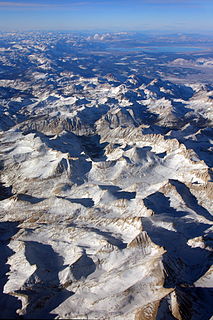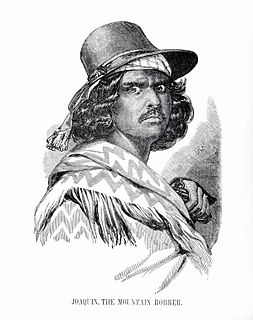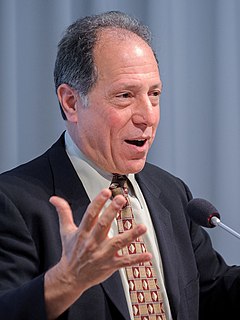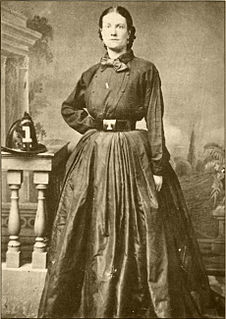Related Research Articles

Christopher Houston Carson was an American frontiersman. He was a fur trapper, wilderness guide, Indian agent, and U.S. Army officer. He became a frontier legend in his own lifetime by biographies and news articles, and exaggerated versions of his exploits were the subject of dime novels. His understated nature belied confirmed reports of his fearlessness, combat skills, tenacity, and profound effect on the westward expansion of the United States. Although he was famous for much of his life, historians in later years have written that Kit Carson did not like, want, or even fully understand the fame that he experienced during his life.

The Sierra Nevada is a mountain range in the Western United States, between the Central Valley of California and the Great Basin. The vast majority of the range lies in the state of California, although the Carson Range spur lies primarily in Nevada. The Sierra Nevada is part of the American Cordillera, an almost continuous chain of mountain ranges that forms the western "backbone" of the Americas.

The California Gold Rush (1848–1855) was a gold rush that began on January 24, 1848, when gold was found by James W. Marshall at Sutter's Mill in Coloma, California. The news of gold brought approximately 300,000 people to California from the rest of the United States and abroad. The sudden influx of gold into the money supply reinvigorated the American economy; the sudden population increase allowed California to go rapidly to statehood, in the Compromise of 1850. The Gold Rush had severe effects on Native Californians and accelerated the Native American population's decline from disease, starvation and the California genocide.

Mission San Rafael Arcángel is a Spanish mission in San Rafael, California. It was founded in 1817 as a medical asistencia ("sub-mission") of Mission San Francisco de Asís. It was a hospital to treat sick Native Americans, making it Alta California's first sanitarium. The weather was much better than in San Francisco, which helped the ill get better. It was not intended to be a stand-alone mission, but nevertheless grew and prospered and was granted full mission status on October 19, 1822.

John Charles Frémont or Fremont was an explorer of the Western United States, military officer, and politician. He was a U.S. Senator from California, and, in 1856, was the first Republican nominee for president of the United States and founder of the California Republican Party when he was nominated.

Bodie is a ghost town in the Bodie Hills east of the Sierra Nevada mountain range in Mono County, California, United States. It is about 75 miles (121 km) southeast of Lake Tahoe, and 12 mi (19 km) east-southeast of Bridgeport, at an elevation of 8,379 feet (2554 m). Bodie became a boom town in 1876 after the discovery of a profitable line of gold; by 1879 it had a population of 7,000–10,000.
The Language poets are an avant-garde group or tendency in United States poetry that emerged in the late 1960s and early 1970s. The poets included: Bernadette Mayer, Leslie Scalapino, Stephen Rodefer, Bruce Andrews, Charles Bernstein, Ron Silliman, Barrett Watten, Lyn Hejinian, Tom Mandel, Bob Perelman, Rae Armantrout, Alan Davies, Carla Harryman, Clark Coolidge, Hannah Weiner, Susan Howe, James Sherry, and Tina Darragh.

The California Trail was an emigrant trail of about 1,600 mi (2,600 km) across the western half of the North American continent from Missouri River towns to what is now the state of California. After it was established, the first half of the California Trail followed the same corridor of networked river valley trails as the Oregon Trail and the Mormon Trail, namely the valleys of the Platte, North Platte, and Sweetwater rivers to Wyoming. The trail has several splits and cutoffs for alternative routes around major landforms and to different destinations, with a combined length of over 5,000 mi (8,000 km).

Joaquin Murrieta Carrillo, also called the Robin Hood of the West or the Robin Hood of El Dorado, was a Mexican-American figure of disputed historicity. The novel The Life and Adventures of Joaquín Murieta: The Celebrated California Bandit (1854) by John Rollin Ridge ostensibly recounts his story.

Carson Pass is a mountain pass on the crest of the central Sierra Nevada, in the Eldorado National Forest and Alpine County, eastern California.

Michael Scott Kimmel is an American retired sociologist specializing in gender studies. He was Distinguished Professor of Sociology at Stony Brook University in New York and is the founder and editor of the academic journal Men and Masculinities. Kimmel is a spokesman of the National Organization for Men Against Sexism (NOMAS) and a longtime feminist. In 2013, he founded the Center for the Study of Men and Masculinities at Stony Brook University, where he is Executive Director. In 2018 he was publicly accused of sexual harassment. He filed for retirement before any charges from a Title IX investigation could be laid.
Judy Yung was professor emerita in American Studies at the University of California, Santa Cruz. She specialized in oral history, women's history, and Asian American history. She died on December 14, 2020 in San Francisco, where she had returned in retirement.
The Nisenan are a group of Native Americans and an Indigenous people of California from the Yuba River and American River watersheds in Northern California and the California Central Valley. The Nisenan people are classified as part of the larger group of Native Americans known as the Maidu, though some dispute the accuracy of this relationship. They have been delineated by their geographical approximation and so in many texts are further subcategorized as Valley Nisenan, Hill Nisenan, and Mountain Nisenan.

Joseph R. Walker was a mountain man and experienced scout. He established the segment of the California Trail, the primary route for the emigrants to the gold fields during the California gold rush, from Fort Hall, Idaho to the Truckee River. The Walker River and Walker Lake in Nevada were named for him by John C. Frémont.

The feminist art movement in the United States began in the early 1970s and sought to promote the study, creation, understanding and promotion of women's art. First-generation feminist artists include Judy Chicago, Miriam Schapiro, Suzanne Lacy, Judith Bernstein, Sheila de Bretteville, Mary Beth Edelson, Carolee Schneeman, Rachel Rosenthal, and many other women. They were part of the Feminist art movement in the United States in the early 1970s to develop feminist writing and art. The movement spread quickly through museum protests in both New York and Los Angeles, via an early network called W.E.B. that disseminated news of feminist art activities from 1971 to 1973 in a nationally circulated newsletter, and at conferences such as the West Coast Women's Artists Conference held at California Institute of the Arts and the Conference of Women in the Visual Arts, at the Corcoran School of Art in Washington, D.C..
American literary regionalism or local color is a style or genre of writing in the United States that gained popularity in the mid to late 19th century into the early 20th century. In this style of writing, which includes both poetry and prose, the setting is particularly important and writers often emphasize specific features such as dialect, customs, history, and landscape, of a particular region: "Such a locale is likely to be rural and/or provincial." Regionalism is influenced by both 19th-century realism and romanticism, adhering to a fidelity of description in the narrative but also infusing the tale with exotic or unfamiliar customs, objects, and people.

Women in the California Gold Rush, which began in Northern California in 1848, initially included Spanish descendants, or Californios, who already lived in California, Native American women, and rapidly arriving immigrant women from all over the world. At first, the numbers of immigrant women were scarce, but they contributed to their community nonetheless. Some of the first people in the mining fields were wives and families who were already in California. A few settler women and children and the few men who did not leave their family worked right alongside the men but most men who arrived left their wives and families home. The number of women in California changed very quickly as the rich gold strikes and lack of women created strong pressures in the new Gold Rush communities to restore sex balance. As travel arrangements improved and were made easier and more predictable the number of women coming to California rapidly increased. Most women probably came by way of Panama as this was one of the fastest trips and one of the most reliable—although expensive in 1850--$400–$600/person one-way. Passage via Panama became much more predictable after the paddle wheel steam ship lines were up and running by late 1849. In Ireland, the Great Famine was a period of mass starvation, disease and emigration between 1845 and 1852 that drove many desperate women to the United States and on to California.

Julia Bulette, was an English-born American prostitute in Virginia City, Nevada, a boomtown serving the Comstock Lode silver mine. She was murdered in 1867, and French drifter John Millain was quickly convicted and hanged for the crime. Subsequent legends surrounding Julia's life and status as a sex worker and madam have grown over time and become a part of Virginia City folklore.

Eagle Valley is the area encompassing Carson City, Nevada. The valley was first settled during the California Gold Rush of 1849. The discovery of Nevada's Comstock Lode in 1859 established the economic importance of the area, which would become the site of the Nevada State Capitol.
Evelyn Sakakida Rawski is Distinguished University Professor in the Department of History of the University of Pittsburgh and a scholar in Chinese and Inner Asian history. She was born in Honolulu, Hawaii, United States of Japanese-American ancestry. She served as president of the Association for Asian Studies in 1995–1996.
References
- ↑ University of Nevada, Las Vegas https://www.unlv.edu/.
{{cite web}}: Missing or empty|title=(help) - ↑ "Susan Lee Johnson". Susan Lee Johnson faculty webpage. 29 August 2019.
- ↑ Susan Lee Johnson faculty webpage (15 May 2017). "Johnson, Susan Lee".
- ↑ Johnson, Susan Lee (2020). Writing Kit Carson: Fallen Heroes in a Changing West. Chapel Hill: University of North Carolina Press. ISBN 978-1-4696-5883-4.